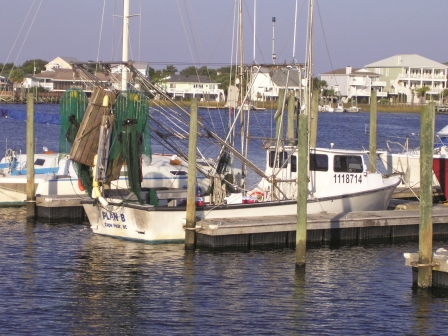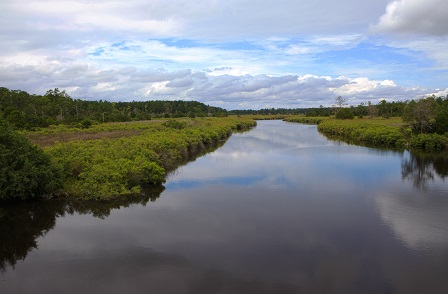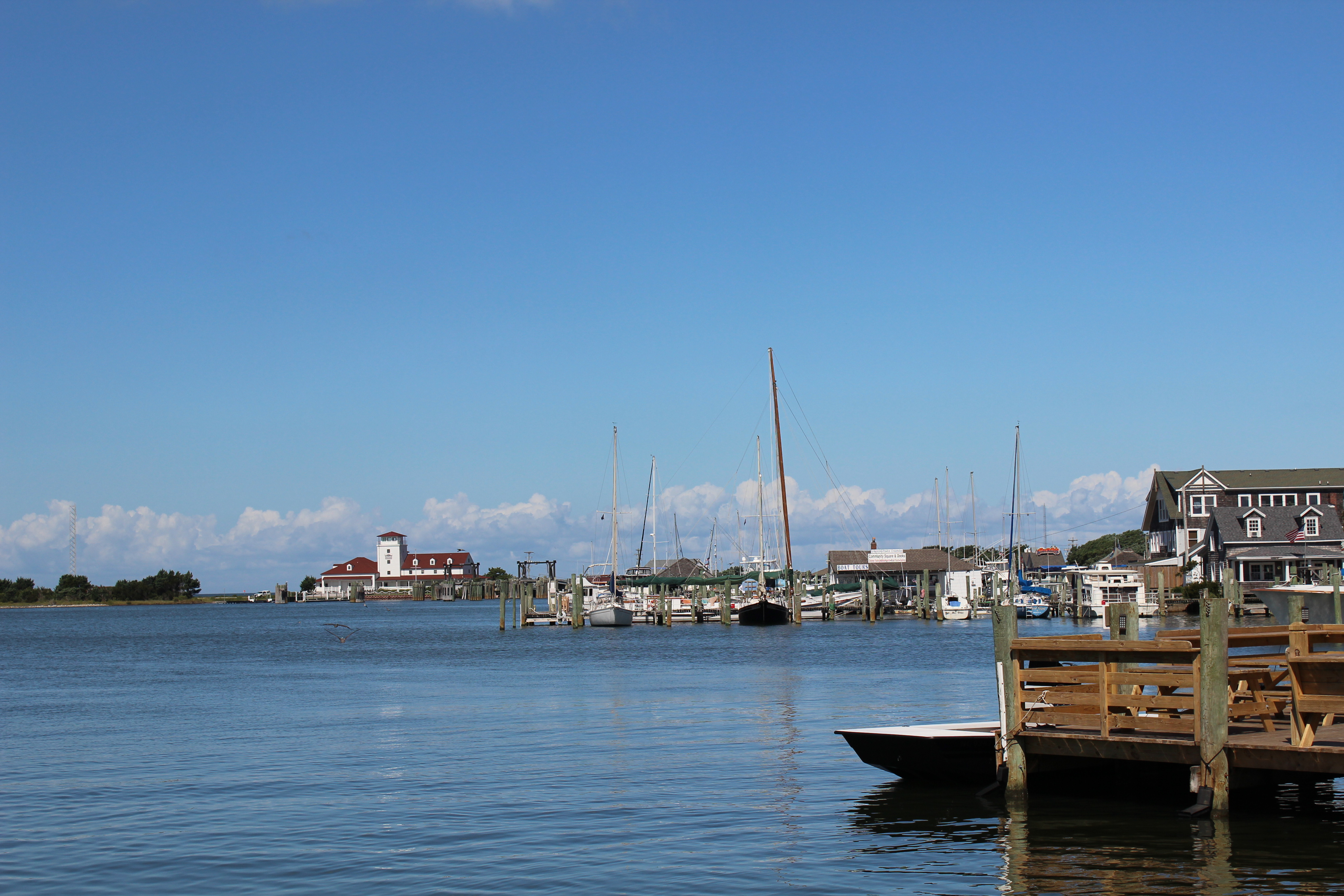Shrimp: No Small Catch, Harvests Features Skimmer Otter Trawls

As Bob Hines adjusts a miniature green net on the side of a skimmer trawl model, he explains how commercial shrimpers can tell when they come upon a bounty of white shrimp.
“White shrimp are very active,” says Hines, a North Carolina Sea Grant fisheries specialist who introduced the skimmer gear in the state. “As the net moves forward through the water, the shrimp jump from the water, marking their presence.”
Because the top of a skimmer net extends above the water surface, it is able to contain the shrimp, Hines explains to a crowd gathering around an exhibit on the National Mall in Washington, D.C. The North Carolina Sea Grant shrimp trawl exhibit was part of “Water Ways: Charting a Future for Mid-Atlantic Maritime Communities” at the 2004 Smithsonian Folklife Festival.
Last summer’s festival featured the rich culture and traditions of maritime workers from coastal communities, including the Core and Albemarle sound regions.
“I come to the festival every year,” says Larry Rockwell of Upperville, Va. “I came to this exhibit because I am fascinated with the technology of boats.”
While several visitors look on, shrimper Bradley Styron of Cedar Island and Hines explain that as shrimp are caught in the tail bag, shrimpers pull in the catch and sort it on a culling table.
Skimmer trawls — in which nets are mounted on frames attached to the sides of the boat — often are preferred in shallow waters along the North Carolina coast, adds Hines.
In deeper water, shrimpers use otter trawls that are attached to vessels by towlines extending to otter doors. The towlines are attached to outriggers or to the stern of the vessel, and the nets are dragged through the water. The doors spread the nets behind the boat, allowing shrimp to enter.
“One advantage of the skimmer trawl over the otter trawl is that you can leave the mouth of the nets in the water and continue fishing while pulling up the tailbag with the catch,” explains Hines. “With an otter trawl, the nets come out of the water when the catch is brought in.”
Built by Steve Lewis of Harkers Island, the model skimmer and otter trawls help showcase North Carolina’s shrimping tradition to visitors from around the world.
“North Carolina has a long history of shrimping, dating to the early days of the 20th century, when the commercial fishery began here and became centered in the area around Southport,” says Hines.
Since he was a young man, Styron has been trawling in Pamlico and Core sounds.
“Most of my life, I have been a commercial fisherman,” says Styron, owner of Quality Seafood in Cedar Island and member of the N.C. Marine Fisheries Commission.
Styron and his crew not only shrimp but also clam and harvest other species, he adds. “I own three trawlers but won’t be shrimping this year because of cheap prices.”
When the season is good, otter trawlers line up like a wagon train in Pamlico and Core sounds, according to Styron’s wife, Debbie.
SHRIMP SPECIES
In North Carolina, commercial and recreational shrimpers use trawls to catch three species of shrimp. The brown shrimp — or Farfantepenaeus aztecu — prefer peat and muddy bottoms but also are found on sand, silt, or clay mixed with shell and rock fragments. The species is more active in open waters at night than in the daytime. The harvesting season is in late summer and fall, usually from July to November.
Pink shrimp, known as spotted — or Farfantepenaeus duorum — also are active at night and burrow into the bottom during the day. Commercial shrimpers harvest this species from April to June.
White shrimp, commonly called green-tailed — or Litopenaeus setiferus — prefer soft muddy bottoms, with the highest abundances in areas of extensive brackish marshes. Commercial shrimpers catch white shrimp from August to November.
In North Carolina, otter trawls are the predominant gear used by commercial shrimpers along the state’s entire coast, especially in deep waters.
From 1994 to 2003, 93 percent of the commercial shrimp harvest in North Carolina was caught with otter trawls, compared to 4 percent with skimmer trawls and 3 percent with channel nets, according to the N.C. Division of Marine Fisheries (DMF).
The skimmer trawl primarily is used in shallow waters in Carteret, Onslow and Pender counties.
Recreational shrimpers also use otter trawls to harvest catch. However, the size is restricted to 26 feet, according to Rich Carpenter, DMF district manager.
In a DMF survey, Carpenter found that recreational gear license holders harvested about 101,325 pounds in 2002 and 47,500 pounds in 2003.
“Recreational shrimpers take about 1 percent of the total shrimp harvest in North Carolina,” he says.
SKIMMER TRAWL INTRODUCTION
In 1989, a National Fisherman article about a Louisiana shrimp trawl — the skimmer — caught the attention of two Carteret County shrimpers, Clinton Willis and Craig Schreck.
The two approached Hines, asking how to obtain the gear and test it in North Carolina.
In June of 1990, Hines, along with Willis and John Weeks, who then taught marine vocations at East Carteret High School, traveled to Buras, La., to test the waters with Gulf shrimpers.
“These two local fishermen were interested in the gear, so we went to Louisiana to try it,” says Hines.
After the skimmer trawl was successfully tested and introduced in North Carolina, it became a popular form of gear in shallow waters.
Don Weeks of Morehead City has been using the skimmer trawl in the Newport River for 12 years. During the white and brown shrimp season, Weeks keeps his trawler moored in the middle of the Newport.
“Eighty-five to 90 percent of the time, I go shrimping at night,” says Weeks. “Most of the time, I start at 8 p.m. and don’t stop until 4 or 5 in the morning.”
In the early 1990s, Hines led a North Carolina Sea Grant study on the skimmer trawl when it was introduced in state waters. With assistance from the Gulf and South Atlantic Fisheries Development Foundation, John Weeks built a set of skimmer trawls and tried them aboard the school’s small work skiff.
“He found good results on white shrimp,” says Hines.
In a larger-scale study supported by the National Marine Fisheries Services (NMFS or NOAA Fisheries), Sea Grant researchers compared shrimp catch between skimmer and otter trawls.
Researchers found that the skimmer trawl was very effective in catching white shrimp in the North and Newport rivers in Carteret County, according to North Carolina Sea Grant’s publication The Skimmer Trawl In North Carolina Estuaries.
“Paul Biermann and I built the first commercial-scale skimmers on his boat, the Frankie and Al,” says Hines. “In the study, we fished the skimmers alongside the conventional otter trawl rig Capt. Will, owned by Clinton Willis,” adds Hines.
More than 23 percent of the total biomass collected by the skimmer trawl was white shrimp — a higher average than with other gear, according to the Sea Grant publication.
“In general, they found the skimmer trawl caught less bycatch per minute than the otter trawl,” the researchers wrote. They also found skimmer trawl bycatch for white shrimp was more likely to survive than otter trawl bycatch.
However, the otter trawl was more effective with brown shrimp.
NEW NOAA STUDY
NOAA Fisheries’ Southeast Fisheries Science Center recently began conducting a research study of the framed-net shrimp fisheries in the waters of Louisiana and North Carolina.
The gear includes the skimmer trawl and butterfly nets that are used by commercial shrimpers in Louisiana. The difference between skimmer trawls and butterfly nets is that the skimmer has no frame on the bottom part of the opening, while the butterfly net has a square frame that completely encircles the mouth opening of the net. Neither has doors like those found on otter trawl gear.
The butterfly net is usually fished in the current much like a channel net used in North Carolina.
Federal and state laws require shrimp trawls to have bycatch reduction devices — which allow small fish to escape from the net before reaching the tail bags. Federal law also requires shrimpers to use turtle excluder devices.
The new study is designed to evaluate the effects of increased use of skimmer trawls by commercial shrimpers, according to Jim Nance, chief of fisheries management at the Southeast Fisheries Science Center’s Galveston Laboratory.
“We want to assess the catch and bycatch from that fishery,” adds Nance. “Skimmer trawling may be more efficient because you use less fuel.”
For the skimmer trawl study, observers will be placed aboard vessels to record vessel and gear characteristics as well as catch and effort data by season and area.
“The study is voluntary,” says Nance. “This particular study will be completed by next year, but additional funding may allow us to go beyond that date.”
NOAA has been gathering data on the otter trawl since the early 1990s, when researchers tested the amount of bycatch caught in the southeastern United States.
Results showed that in the Gulf and South Atlantic shrimp fisheries, about 51 percent of the catch by weight was composed of finfish, according to a NOAA Fisheries report. In addition, the researchers found that 18 percent of the catch was made up of commercial shrimp species, 13 percent by noncommercial shrimp crustaceans and 18 percent by noncrustacean invertebrates.
SHRIMP HISTORY
Historically, a wide variety of gear has been used to harvest shrimp.
Native Americans caught shrimp for subsistence using dip nets, seines and weirs.
They also used traps made from leaves and cord from plant fibers, possibly extracted from bear grass and palmettos, according to Hard Times and a Nickel A Bucket: The Struggle and Survival in North Carolina’s Shrimp Industry by John Maiolo.
Just prior to World War I, two developments — a new Southport cannery and the adoption of the otter trawl — stimulated a dramatic growth in the shrimping industry, according to Hard Times.
“The otter trawl revolutionized shrimp fishing and replaced the long-haul seine that could only be used in shallow waters,” writes Maiolo, now an East Carolina University professor emeritus. “The efficient otter trawl could be used either inshore or in deep water, needed few men to operate it, and yielded a greater production per unit of effort.”
During the late 1920s, Brunswick County’s monopoly of shrimping fisheries began to erode as interested shrimpers from Carteret County arrived to learn how to catch the crustaceans.
However, Maiolo adds that commercial shrimping did not take off until after 1933 — when production steadily increased from 338,000 pounds in 1931 to more than 2.5 million in 1934.
“For a long time, shrimp were considered pests,” says Hines. “Southport was the first area for commercial shrimping in North Carolina.”
In Hard Times, Maiolo describes the editor of the Southport State Port Pilot recalling his first months there in the mid-1930s: “Living on the waterfront, his sleep was ‘rudley shattered by the discordant sound of many noisy gasoline engines’ as the trawlers moored along the docks in the harbor prepared to leave in the early morning.”
As more people began shrimping, a unique method of harvesting called “channel netting” developed near Barkers Island in the 1930s.
Since then, this form of fishing has undergone numerous modifications.
“The modern version is set on the stern end of the boat, with ends of the staffs running across the board and resting up the gunwales,” writes Maiolo, a former North Carolina Sea Grant researcher.
As the ebb tide begins to run, the captain locates the edge of the channel or bank, usually with a long pole, and then marks the edge with a buoy, he adds.
“Then, making allowances for anchor line and bridge length, the fisherman throws one of the anchors overboard and sets it firmly,” according to the book. “The net is then pulled off the stern so that approximately one-third of it will extend off the bank and into the channel.”
Following World War II, the shrimping industry began to emerge as one of the state’s most important fisheries.
By 1953, shrimp production in North Carolina climbed to more than 14 million pounds, according to Maiolo. Throughout the 1950s and 1960s, larger vessels that stayed longer at sea were introduced.
The 1980s brought large harvests for shrimpers. “In 1985, I caught more than 1,500 pounds of shrimp in one night on the Pamlico Sound,” says Styron.
TRAWLING RESTRICTIONS
For a number of years, shrimp trawling has been restricted in designated nursery areas in North Carolina.
“These are the most sensitive areas to bottom-disturbing fishing gear,” says Carpenter. “Also, these are areas where very young fish, crab and shrimp develop.”
Some recreational fishing associations want more trawl restrictions for commercial shrimpers.
“We would like to see less destructive gear used in inland waters like the sounds,” says Doug Roberts, board member of Coastal Conservation Association (CCA), North Carolina.
CCA prefers that shrimpers use skimmer trawls over otter trawls, which Roberts argues drag the bottom and damage nursery areas for finfish.
“We need to do everything possible to reduce finfish bycatch,” he adds. “The skimmer trawl seems to minimize bycatch.”
Because of the controversy over shrimp trawling and decline in price due to foreign imports and other factors, DMF moved up the date for the state’s first shrimp management plan. The division expects to have the plan completed in 2005, according to Carpenter.
“The plan will examine all aspects of shrimping in North Carolina, including bycatch, impacts on habitats, economics, gears and practices utilized in the state,” he adds.
For up-to-date information on turtle excluder devices and bycatch reduction devices for commercial shrimpers, visit Louisiana Sea Grant’s fisheries Web site: www.seagrantfish.lsu.edu/management and click on “gear.”
For more information on the North Carolina’s shrimp management plan, contact the N.C. Division of Marine Fisheries, www.ncfisheries.net or 800/682-2632.
This article was published in the Holiday 2004 issue of Coastwatch.
For contact information and reprint requests, visit ncseagrant.ncsu.edu/coastwatch/contact/.
- Categories:


